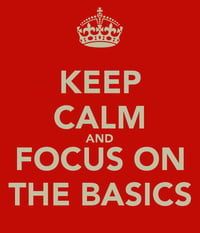
Just like you look to eliminate waste in your business processes, we think you should look to eliminate waste and simplify your improvement work. That's why today we want to talk about standard work. We’re not going to give you a mega list of everything that standard work could be; we’re only going to talk about what it must be. These are the five simple, yet critical, standards for your standards.
1. Reflects Reality
It's not enough to come up with the best way to do something and write it down; you also have to make sure that the new standard you've come up with actually occurs in real life. If the standard work on the books doesn’t reflect the work as it is being done on the front lines today, it isn't actually standard work. If the standard work isn't followed, leaders need to ask "why?" as part of a daily lean management system. Was the training not good enough? Are there legitimate barriers that get in the way of doing things the right way?
2. Up To Date
Processes tend to change over time, so it is important to revisit, re-document, and recommit to standard work frequently. It's possible that people are forgetting the improvement...but it's also possible that they've improved it since you last looked. Standard work documents are living documents and you need a process for turning a Kaizen improvement into a new version of the standard work. And, thinking back to point #1, you have to make sure everybody adopts the new standard.
3. Complete & Accurate
Every material and critical part of the work must be considered and documented. Otherwise, you can get a false sense of security, but still produce inconsistent results and introduce waste. Incomplete standard work is often the result of process changes over time, so see #1. Don't worry about documenting every minute detail, but be sure you've documented the things that matter for safety, quality, and other key outcomes. The initial work that goes into creating the standard is essential to its usefulness. If the correct current best practices aren’t uncovered and used for the standard, there isn’t much point to the exercise at all.
4. Understandable
If the standard work cannot be understood by those doing the work (and by those managing the work), it can’t be executed correctly. It should be in an easy to understand format with visuals, where applicable. Sometimes a diagram tells a thousand words, to modify the old cliché.
5. Concise
While it must be complete, it should stick to the relevant information and be free from long form commentary, industry jargon or instructions that have no real impact on the results of the work. Or, maybe we should have just said, "Be concise." :-)
Don’t get overwhelmed with standard work, get started. If you produce documentation that meets these benchmarks, you’ll have the perfect platform for consistency, quality, and ongoing continuous improvement.
![The 7 Wastes of Lean [Free eBook]](https://no-cache.hubspot.com/cta/default/326641/b3d32e45-87f5-4557-865f-772d99911733.png)


Add a Comment